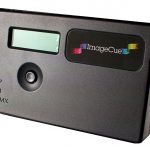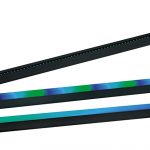There was a time in the not-too-distant past that video racks were big. Not because we needed room for all the blinky lights or Star Trek navigational gear. The reason was because video people, like our audio cousins, tend to be very …um…. thorough (read retentive to a fault).
See, video is a visual medium and, as such, we need to see everything. Every camera, every source, and every destination needs confidence. In a broadcast truck you’d see an entire wall of smallish tube monitors that would be literally half the weight of the truck. In a fly pack you would have entire half-packs full of monitor racks. Things got better when monitors turned flat, but not much better. Even though weight and size went down and resolution went up, you still had the real estate issue. And the cases. If you were on a corporate graphics gig with a five-wide blend and 20 laptop/desktop combos driving everything it got worse exponentially. After all, everything had to be converted/processed, routed, and ultimately sent to the right place. For years, the security camera feeds at the local Seven11 quickie mart had more capability than what our switchers had, albeit not quite the quality we needed. Then switchers started to feature multi-monitor out capability. We now had only to hook up a single D-sub to a readily available decent large flat screen, and viola! We could see (almost) everything.
So what do I do if I don’t have the scratch to upgrade the switcher, or worse, what if the switcher still doesn’t have the multiple out capability I need? If only there were a small, single rack-space unit that could monitor four, eight, even 16 feeds…mmmmm…
The MultiView 16 from Blackmagic design does just that. It’s a 1RU device with 16 looping SDI inputs on BNC. It’s capable of a 2×2 out for 4 sources, 3×3 for nine, and 4×4 for 16. Output comes from a single HDMI or 2 x 6G-SDI and 2 x HD-SDI BNC’s. REF IN is available when used with other gear, and it’s controllable via RS-422, USB, as well as Ethernet. It also has a built-in switching power supply for multi country friendliness. (A quirk I found odd at first on unpacking was the fact that it did NOT come with an IEC cord or any of the funky voltage adapters of old. I felt slighted at first, but then it dawned on me — what cable do I have more of than any other just lying around? IEC. How many adapters end up gathering dust or in a landfill? Lots. So good for BMD for thinking down that road!) Its panel and chassis are extremely rugged due to machined aircraft aluminum. It has some terrific features and also some quirks that we’ll look at.
Around the Unit
 As I said, it’s 1 RU and only half rack deep. And for a little guy, it’s loud. Most everything these days are loud, but it’s doing a fair amount of duty, so it’s excusable. All buttons on the front are of the tactile, rubberish feel that is slightly stiffer than most…a feel I like. There is also a small LCD screen with a jog wheel for setup and quick view adjustments. In back there are 16 looping SDI in 6G flavor for future-proofing. Each input is standards-independent, so get crazy with hooking anything to it. Each loopout is re-clocked and low jitter with frame resynch. The USB and RS-422 control inputs are fine and offer some real advantage to a permanent install, but the best flexibility for control is through Ethernet. If desk or rack real estate is at a premium, you could mount this unit elsewhere and access all the controls quite easily through the provided MAC/WIN software.
As I said, it’s 1 RU and only half rack deep. And for a little guy, it’s loud. Most everything these days are loud, but it’s doing a fair amount of duty, so it’s excusable. All buttons on the front are of the tactile, rubberish feel that is slightly stiffer than most…a feel I like. There is also a small LCD screen with a jog wheel for setup and quick view adjustments. In back there are 16 looping SDI in 6G flavor for future-proofing. Each input is standards-independent, so get crazy with hooking anything to it. Each loopout is re-clocked and low jitter with frame resynch. The USB and RS-422 control inputs are fine and offer some real advantage to a permanent install, but the best flexibility for control is through Ethernet. If desk or rack real estate is at a premium, you could mount this unit elsewhere and access all the controls quite easily through the provided MAC/WIN software.
Oh the Views, the Views…
The MultiView 16 has an output of 2160p @29.97 (progressive or interlaced), so if you hook it to a UHD monitor and run it in 2×2, you’re still seeing a full HD monitored signal. Even in 4×4, you’re seeing 960x 540! Since the HDMI, HD-SDI and 6G-SDI outs are all concurrent, you can hook to just about anything in a control room or on a gig and provide views for everybody in super-sharp detail. The one quirk that I had to overcome was the fact that the front panel buttons are laid out not left-to-right, but in a cascading top-down style. This could get a little confusing if you’re in a hurry and need to see your displays exactly as they are laid out, say, from behind a screen on a show. In a studio, it makes sense, but you really have to think through your layouts in advance. The software made labeling each input and/or output quite easy, however. So there’s a bit of a learning curve. There is a SOLO button, which is pretty handy if you need to see a single input overtake the whole monitor. But again, you’d need to know how you labeled each one, and in which order. Maybe this will be sorted out in a future software release? I ran the latest version of Blackmagic VideoHub, and things cleared up nicely, however, so there are work-arounds.
Cost Benefits
I am not in the lucky crowd that gets to play with UHD monitors on a regular basis, and I didn’t have one for this run through, but the MultiView 16 looked outstanding on my 1080 LG. There are some obvious cost savings when you invest in one of these units—a single 55-inch UHD TV goes for under $1,000, so with the street price of $1,495 for the MultiView you’ve got a crazy monitoring solution for under $2,500. You save on weight, electricity, and pack space. All of which look better to your bottom line.
At a Glance
One Screen, 16 Scenes
The Blackmagic Design MultiView 16 lets users see up to 16 SDI inputs on a single Ultra HD display — the first native Ultra HD multi viewer that lets them leverage Ultra HD’s ability to display images at twice the resolution of an HD multi view. With full frame re-sync in each input, it supports the display of up to 16 mixed SD, HD and Ultra HD video sources, all at the same time.
MultiView 16
PROS: Super compact, well designed, flexible
CONS: Button assignment/layout
FEATURES
- Displays up to 16 SDI sources on a single HD or Ultra HD display via SDI or HDMI.
- 16 multi rate 6G-SDI inputs with loop thru, compatible with all SD, HD and Ultra HD equipment.
- Automatic frame re-synchronization allows simultaneous display of mixed SD, HD and Ultra HD formats.
- Viewing options include solo, 2×2, 3×3 or 4×4 grid views
- Supported output resolutions: 1920 x 1080 and 3840 x 2160
- Front panel controls with dedicated source buttons, LCD screen and spin knob control
- Built in 90V-240V AC international power supply
- Remote control via Ethernet using Mac and Windows software
STATS
|
Size |
1RU |
|
Price (MSRP) |
$1,495 |
|
More Info |



